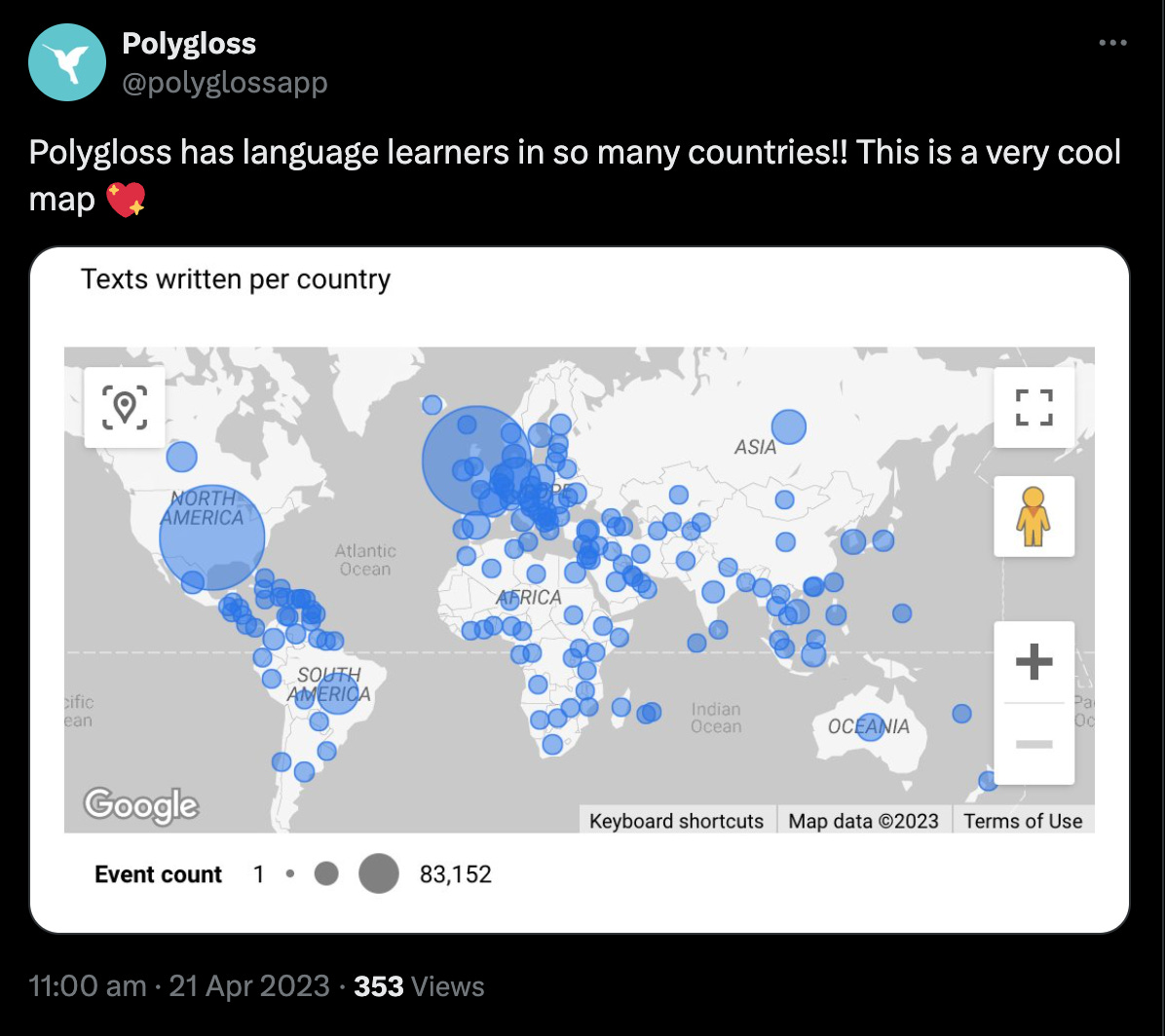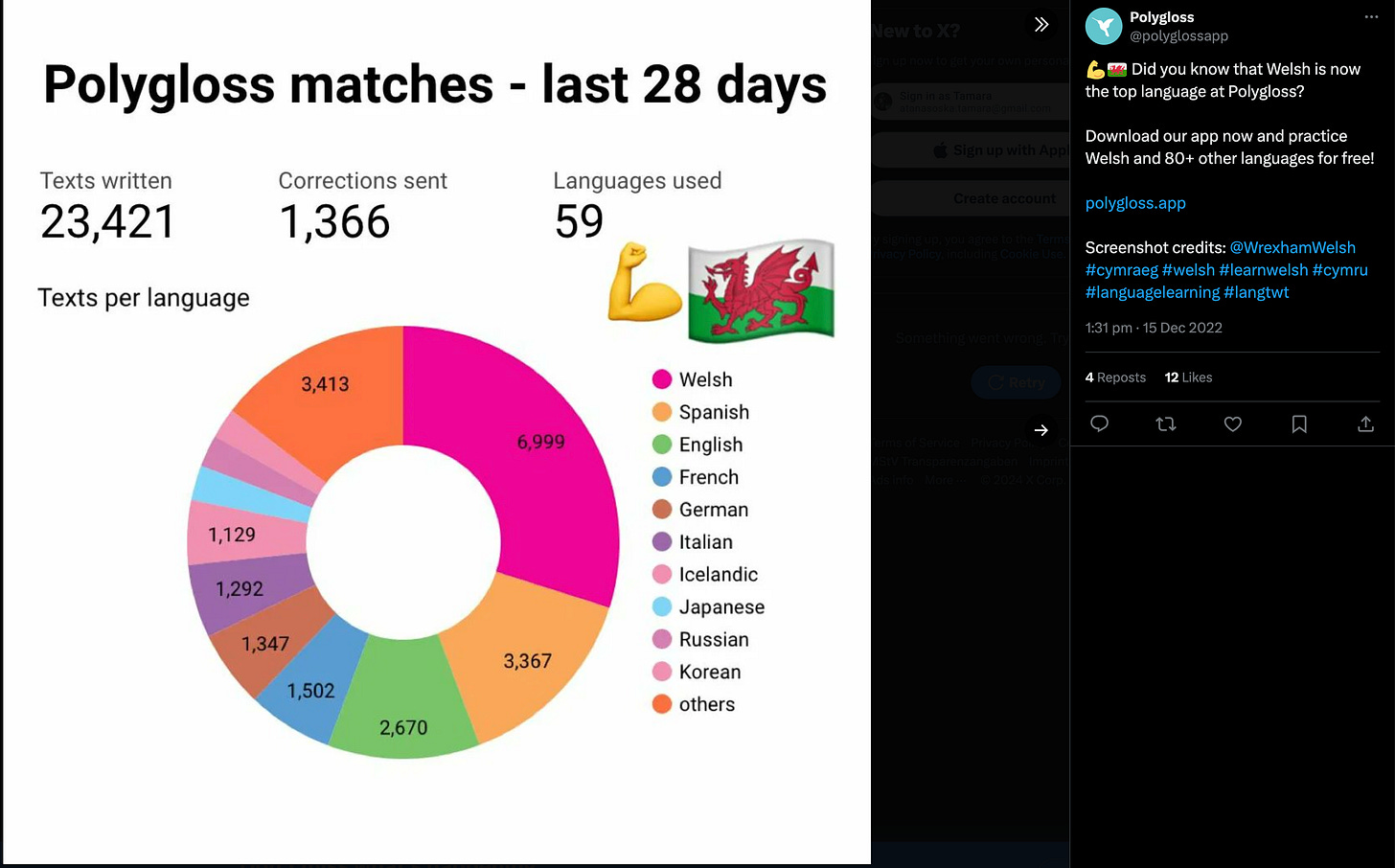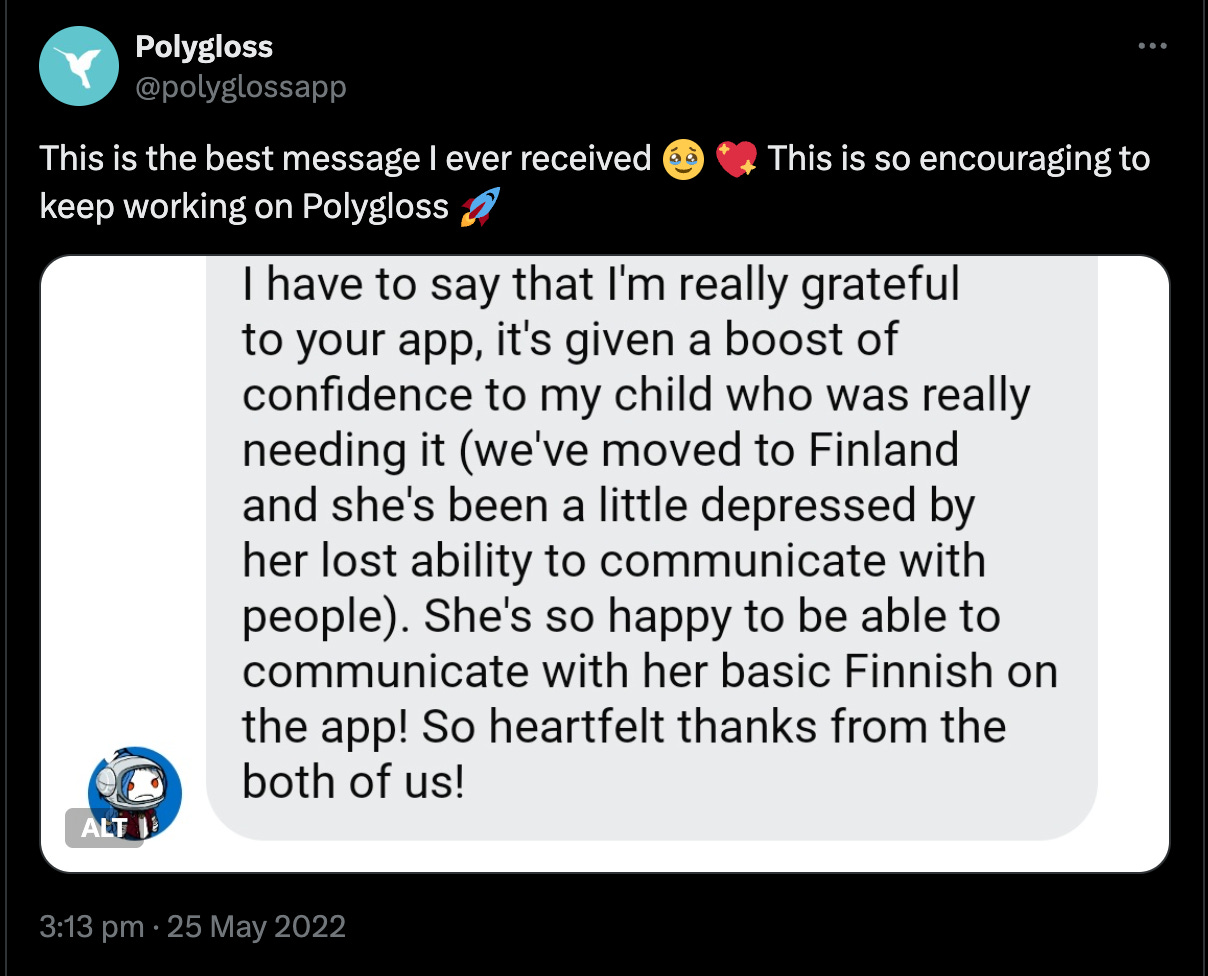As a continuation of our conversation last week, we welcome very special guest today: Etiene Dalcol. She is a fellow computational linguist, a software engineer and the founder of Polygloss - a language app for the intermediate plateau.
Etiene currently lives in Barcelona, Spain. When he isn’t working, she plays in a local bloco, a marching band part of the big informal street parties of the Brazilian carnival. For her, it is a chance to celebrate the beauty of Brazilian culture, find community, and practice Spanish.
I met Etiene on Twitter many years ago, and we’ve stayed in touch, united by similar views of the world and love for language as a phenomenon. It is always a pleasure to talk to her.
In the interview below we discuss the intermediate plateau and how it is to build an app for that particular stage in the language learning journey. You may find insights that unblock you if you are stuck, or inspiration to create something of your own.
Note before you start reading: The core Polygloss dynamic matches pairs of participants who describe images to each other in the language they are learning. It is an asynchronous match, meaning the users can play anytime, anywhere. Users gain points if they successfully guess the image described or vice versa.
How did the Polygloss concept come to be, and how did it evolve?
Etiene: The concept for Polygloss came to be exactly because I wanted to work with the intermediate plateau. I wanted to do something in that niche, but I didn’t know what. I started by making social media accounts for Polygloss and talking to people and language-learning communities. I tried to understand other people’s difficulties in that area why they felt they hit a plateau and what helped to get out of it.
The decision to focus on the intermediate plateau was fixed from the beginning, a core design decision. From there I started to have a lot of influences, the biggest one being a colleague presenting a game for collecting data. He was researching how people come to a consensus during a dialogue by using an image-based game to elicit a conversation topic. I immediately thought it was useful and that I could use a similar setup, but in many different ways as he was using it exclusively in English just to get answers to his research questions.
If people can pick their language in that setup, they could use this to practice any language. I started thinking about what kinds of images I would like to use and how I would separate them, which led me to categories. Then, in a matter of weeks, I got the images. For me, it was very important that I chose the images. I didn't want to use AI-generated stuff.
There was also the constraint of Polygloss being a mobile app on a phone screen. You have to fit multiple images. They have to be visible and the users have to be able to understand what's going on. If it's a complex image with lots of details, it's going to be hard. So I had to curate it well. It was hard finding the images, so some of them are not really good. But then, from time to time, I add more when I find better ones, or replace some of the existing ones.
Did you identify a personal need to work with the intermediate plateau? Or was it just by listening to the community?
Etiene: From my own needs. I also looked into the market options. When you start learning a language, there are a ton of existing resources. I'm not going to go into the merits of whether they're good or not. Duolingo already exists, and if we're starting from scratch you're going to learn something from it.
Maybe there are better ways. If you paid a private teacher, you would learn much better. There are existing resources for many languages that are free, easy to find and widely known. Of course, if we're learning an under-resourced language, that's a bit trickier, especially finding materials. But in that case, this problem would exist for every level, not just for the beginner level.
Were the low-resource languages part of the primary motivations for you, or did that come to be in later evolutions?
Etiene: It was. Because I already had the concept for the images, I realized it could be used for any language, including a language that has no resources. If someone can write and speak a language, they can use Polygloss. There is a difficulty of having the critical mass, which is Polygloss’ biggest design challenge. The game needs to have enough people in a language community for there to be enough activity. But if there is someone, they can use the app.
I've seen the app being used for multiple under-resourced languages. For a while, we had Welsh as the top language on Polygloss, and it was awesome. Now I have a lot of Welsh data that maybe I can use for something in the future and release some study or just release the materials so that researchers can study it.
However, the intermediate plateau was the biggest focus because that was my difficulty when learning all the other languages. After the beginner materials, you are left with jumping into a conversation with other people. I felt that very often the beginner material was too easy or too boring for me. At the same time, jumping into conversations wasn’t feasible yet. I was not ready for that.
Of course, I could insist and make myself do it. However, sometimes having such an opportunity is difficult, as you need to have a regular practising partner. I tried using some other apps specifically designed for this, and because people are somewhat flaky, you often have a conversation with a new person and start the conversation in the same way. It felt as if I was always stuck with the same topics, and always practicing an initial interaction with a different person.
This is such a great insight. The process of getting fluent came to my mind when you are at a point when you comprehend a lot. You can initiate the small talk beginning. “Oh, hi! This is me. This is what I do. Blah, blah, blah.”, and then you always feel like you cannot say anything more complex. It's detrimental to your self-confidence because you ace these conversation beginnings, but it stays at just that. Having a chance to practice different topics than standard daily ones is very valuable.
Etiene: Yes. I wanted something that would force me to practice in a way that I can still talk about things that are important to me, but I wanted to be basically prompted out of the usual script, if I can put it that way.
Did the design of the app change radically from what you had imagined? Starting from the university paper up to this moment. Did you learn some things over the years that changed the app in some fundamental way?
Etiene: It has been pretty stable. I tried experimenting with other formats, but they required content creation, which was taking a lot of time that I could invest into other aspects of the project, feature-wise, marketing-wise or else.
I tried investing in content creation, but people weren't using the feature enough to justify that investment. The feature consisted of asking a question, and people answering the question in the language that they were practicing. It was a cool feature, but I ended up scraping it. With that gone, it was back to the initial gameplay. I did add the option to record and send audio messages. This is pretty different from the initial design. It adds a completely new, dynamic layer to the game while preserving the same dynamic. So in many ways, nothing fundamental changed.
What would you try with Polygloss if you had resources for it? What would you do in addition if you could have the resources for it?
Etiene: There are a couple of things.
One of them is making sure people get answers faster. Usually, they start playing with someone, and then they have to wait until the other person gets back to them. For a new player who is just getting to know the app that could be a big drop-out moment.
I have the idea of adding some kind of bot or playing with the historical data. Of course, that loses some of the aspects of actually talking to a person, but it has its advantages as well. I don't plan on eliminating the person-to-person aspect because that's what creates the data that could be used. There's no need to change the current dynamic. It would just add the option to do a different kind of interaction.
I also investigated the possibility of doing something that looks like a Twitter timeline where you scroll and you see the messages that everyone is writing in that language. That would add a little bit of input training and also give people a bit of an idea of what is expected when you start writing. When users open the screen and it's their time to write something, that's also a big drop-out moment because people get a little bit intimidated. We have a tutorial that explains a little bit the dynamics and contains examples, and I think this gives people a little bit more safety, but more examples would still be helpful.
Agreed, it's quite a big deal to put yourself out there for certain people. It is a great idea, as people can choose what part of the app they engage with. I'm one of those people who have no shame. I'm not scared of looking stupid, so I would just go and say things, but every day I talk to people who find this really intimidating, even in this anonymous form that Polygloss uses.
Etiene: It's also something that consumes a lot of energy. There is a concept in second language acquisition about the depth of processing. The more processing you use, the more you learn - but you need to have energy to do that depth of processing, right? And sometimes you don't have the energy to create content. I think one of the reasons that Duolingo is successful is because it's easy. Maybe it's not as helpful because it's easy, but that's something you can do even when you get home tired, after a 12-hour shift. You don't have the energy to do anything but five minutes clicking around on Duolingo really doesn't take any effort. It's effortless. You can do that every day, and be very consistent. In the end, you're going to gain something out of it. And I think Polygloss sometimes is too hard, so you need to okay, sit down, and be like: “Ok, now I'm going to study. Now I'm going to create sentences”. Not everyone has the energy to do that all the time, at a random time. Some people do, but for some people, it might be too big of an effort. So this would give people something else to do in the app. And then maybe they will feel inclined to write one sentence once they're already there.
So, kind of a gradation of effort. I use a similar tactic. I always keep a list of things that I do, and some of them are for when I have no cognitive capacity to engage at a deeper level.
What are the Polygloss user stories that keep you going?
Etiene: I have a story. A family moved to Finland with an 8-year-old daughter who was learning the local language. It is quite a shock to move somewhere new and start talking to people, so the mom found Polygloss. She reported back that she was happy that she found the app because it was a safe environment for her daughter. She liked that there are no open-ended conversations, that people are limited to the task of describing an image and that there aren’t any personal details being exchanged. It really helped her, and she's more confident now. I almost cried reading that message.
What kind of practical suggestions do you have for the people that hit the intermediate plateau? What’s your go-to way out of the rut?
Etiene: There are two secrets to overcoming it. One is putting in the time—there's not much you can do around that—and then there's what you do with that time. When you're studying with a teacher, the teacher will be able to design the activities in a way that's sufficiently well-rounded. But when we're self-studying, it's very easy to spend a lot of time on the things we find more pleasant. It's very important to follow our interests so we can spend more time studying and immersing in a language. But it's also important to follow a strategy so we don't accidentally neglect important things. If you read a lot, it's important to remember to do some writing from time to time. If all you do is listen to podcasts, it's important to remember to chat with others from time to time.
How did your language learning journey and you as a learner change over the years?
Etiene: It really varies by which language I'm learning and why. I used to study every day, but that was all I did after work and all I had energy for. Right now I stopped being in a rush because I'm living in a country that speaks my target language. So every day I learn something, even against my will. I also learned to respect my body more, how to watch for the signs of burnout, that taking breaks is okay, and how to be kinder to myself. I'm not learning as fast as before, but I also have a more fulfilling life that's not entirely consumed by language learning. It was a lot easier to study when I had no friends :D, but I prefer also having a social life and taking things slower.
The interview ended abruptly because we ran out of time. Hopefully, there will be more opportunities to speak again, about so many more topics. I hope you enjoyed the conversation!
Peak ahead
The next article will focus on the “language experience” or how we exist in a language.







